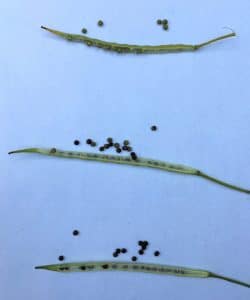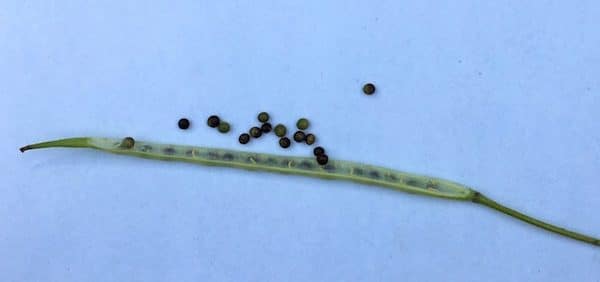Optimal swath timing for canola yield and quality is when at least 60 per cent of seeds on the main stem are showing some colour change. Here’s how to determine seed-colour change.
Step 1. Start inspecting your canola field approximately 10 days after flowering ends. The end of flowering is reached when only 10 per cent of plants have any flowers remaining.
Step 2. Take time to assess a field. Sample at least five plants in several locations throughout the field to make an accurate assessment of the overall maturity of the crop. Stand on the road or in the back of your truck box to help identify the ripest and least mature areas of the field (e.g. low lying vs. higher elevated areas of the field,) and ensure these areas are included in your sampling.
Step 3. Use the illustration (See page 1 here) to assist in determining seed colour percentage on the main stem. Include seeds with small patches of colour (spotting). Also look for firm seeds in the top pods that should roll between the thumb and the forefinger without being easily crushed. Note that pod colour is not a good indicator of seed colour change. Pods have to be opened.

Step 4. Always inspect seeds in side-branches as well, particularly in fields with low plant populations that have a large amount of branching. Prior to swathing, these seeds should be at least firm to roll without any translucency, but they may still be green.
Step 5. Once all areas are sampled, average out the percent seed colour change for that particular field. Also note the range in maturity observed among sampling locations.
Step 6. Continue inspections every two to three days until ready to swath.
Responses to August 19, 2020 Canola Watch survey: Last week, in the Canola Watch email, we asked a survey question: What is your trigger to start swathing canola? The top selection was “When the first field has 60 per cent seed colour change”, with 45 per cent of responses in Saskatchewan and Alberta and 41 per cent in Manitoba. Next was “Swathing?! Straight combining is the way to go”, with 33 per cent of responses in Alberta and 25 per cent in Saskatchewan. The straight combining response was actually in third spot in Manitoba, with 22 per cent of responses, behind “When the first field has 30 per cent seed colour change” at 31 per cent.

